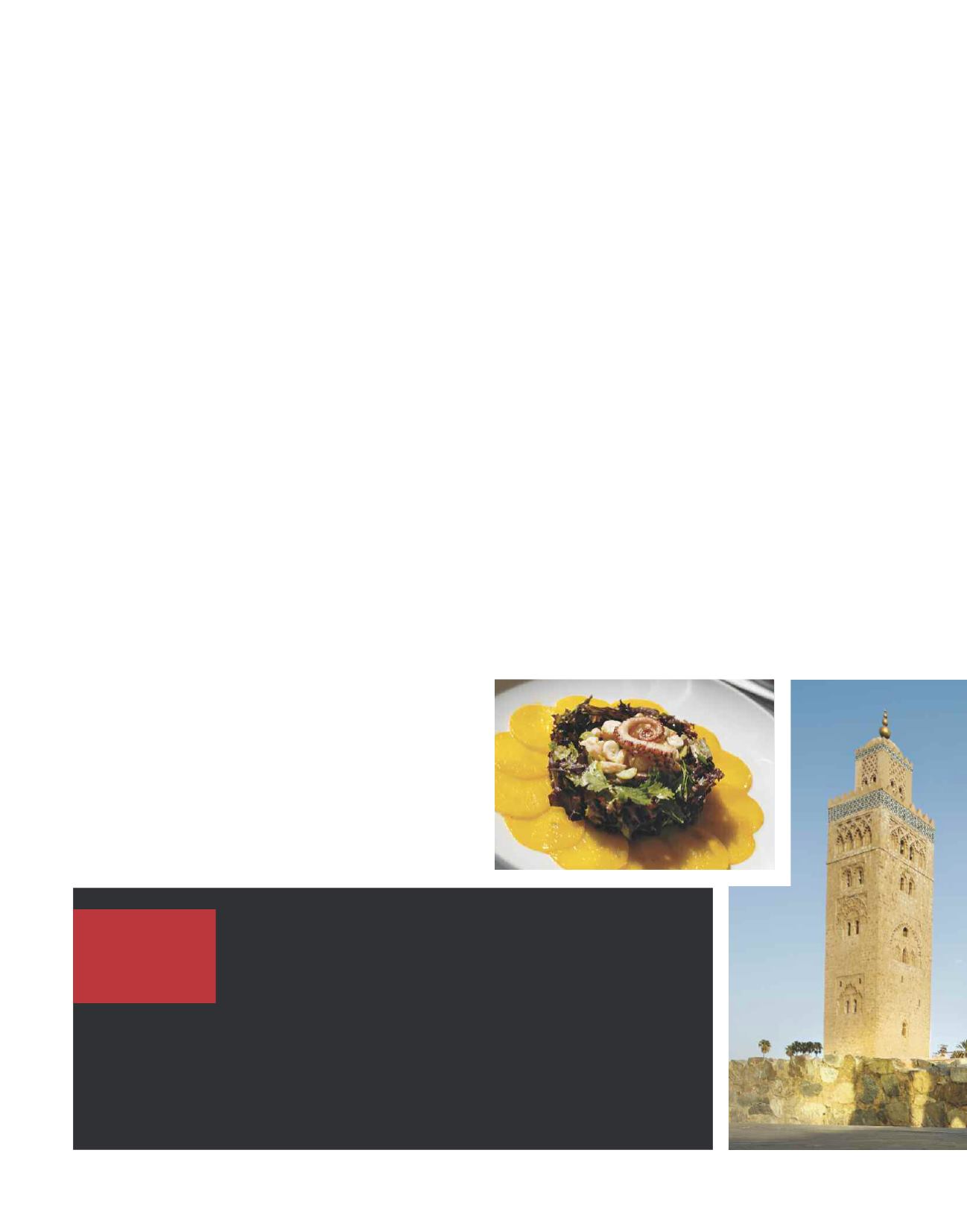

hen the Almoravids raised Marrakech’s mighty walls
in the 11th century, surely they never guessed that the
medina
(old
town) would remain intact and virtually unchanged nearly a millennium
later. But while roaming the souks (markets) can feel like medieval
time travel, elsewhere, Marrakech has rushed headfirst into the 21st
century with on-trend boutiques and glamorous dinner clubs. Indeed,
Morocco’s Red City walks a fine tightrope between past and present,
chaotic and blissfully calm, pulling off the entire act with inimitable
style. Consider the following three-day itinerary to pinpoint must-sees
and get your vacation started. If you have additional time, explore at
a more leisurely pace — or seek out your own Marrakech delights.
Day 1:
Medina Magic
Begin your trip by throwing yourself in the deep end: Djemaa el-
Fna. This sprawling, disjointed square feels like stepping onto a
giant film set, complete with snake-charming, monkey-balancing,
drum-beating theatrics. The name translates as “assembly of the
dead”; fittingly, it was once a public execution ground. It is very
much alive today, however, and serves as the centerpiece for
Marrakech’s medina.
Wander around the square and you’ll soon become part of the
show. Keep spare change handy for the juice carts or if you fancy hav-
ing your photo taken with a tassel-hatted water carrier, a cobra, or a
cheeky Barbary macaque. And if you don’t want a shoeshine or henna
tattoo, the golden rule is to say “
Non, merci
” and just keep walking.
From the square’s northern flank, you can easily dive into the
mazy souks, where the bewildering twists
and turns leave even cartographers baf-
fled. Quite frankly, you’re bound to get lost
at some point (It’s part of the fun!) so heed
this navigational tip: locate one of the
main arteries, and you can find your way
out. Just don’t leave until you find Au Fil
d’Or at 10 Souk Semmarine, for beauti-
fully tailored kaftans. A little farther on, at
Patisserie Belkabir, the syrupy Moroccan
sweetmeats make terrific gifts.
Diverting off this main drag brings you to other souks, such as
the Criée Berbère, where Berbers haul their hand-woven rugs to
the daily 4:00 auction. Souk Smata brims with spangled babouche
slippers, and you’ll want your camera handy for Souk Sebbaghine,
where brightly hued skeins hang to dry against sunbaked walls.
Miracle lotions and potions are sold in the herbalist stores lining
Rahba Qedima square. Or, you can simply sit back and survey the
action over a spiced coffee and snack at Café des Épices.
After a morning of haggling, it’s time for a cultural afternoon,
so stop in to Ali Ben Youssef Medersa, a former Quranic school
and a textbook example of Moroccan craftsmanship. The current
building dates to the 16th century, and its geometric
zellij
tiles and
lace-fine stucco are dazzlingly intricate.
Book a table for dinner at gastro mk, the renowned restaurant
at maison mk hotel, and end your day with a five-course tasting of
Moroccan-French flavors. (Note: gastro mk limits its external guests
to 10 per night, so be sure to call ahead to make a reservation.)
Day 2: Rock the Kasbah
There’s still plenty to see in the medina, but swing your focus south
of Djemaa el-Fna. As the city wakes up, go for a walk along Rue
Riad Zitoun el-Jedid, which has a more laid-back vibe than the
souks. The cobbled, bazaar-like street provides a tantalizing slice
of local daily life, with cubbyhole carpentry workshops, apothe-
caries, groceries, bakeries, and tailors, where old Singer sewing
machines are still en vogue.
40
INTERVAL WORLD Spring 2015 IntervalWorld.com
It’s quite easy to spend much more money than you had planned at Djemaa
el-Fna unless you have your wits about you. Remember, no photograph is free,
and those wily snake charmers and smiling Gnaoua musicians are out to extract
as many tourist dirhams as they can. The typical going rate for a snapshot is 10dh
to 20dh.
Haggling is expected in the souks, but how low can you go? As a rule of thumb, start by knocking
70 percent off the first quoted price. Then, work from there toward a more realistic 50 percent. You’ll
need to be polite but firm to strike the best deal.
Petit taxis (often Peugeots on their last legs) are cheaper than grand taxis (Mercedes). Ask the driver
to switch on the meter if it’s working, or agree on a price beforehand. Most of the medina is off-limits
to all forms of traffic — save mule-driven carts.
Some
Inside
Scoop
RIGHT: Morocco was a
French protectorate for
many years, and the
latter’s influence is felt in
the cuisine today.
FAR RIGHT: Soaring 230 feet
above the city, Koutoubia is
one of Marrakech’s most
recognizable landmarks;
many visitors use the
mosque as a reference
point to navigate around
the city.

















